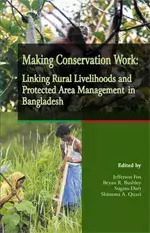
Bangladesh is among the poorest and most densely populated nations in the world. The difficulties that Bangladesh Forest Department officials face in promoting the conservation of flora and fauna are among the most severe found anywhere. The papers included in this book point to several important conclusions about linkages between rural communities and conservation in protected area management. First, they suggest that strategies to link rural livelihoods and conservation are not a universal panacea for conservation problems. Promoting the management and even domestication of non-timber forest products may give local communities incentives for protecting these species, but this may have little or no impact on overall habitat conservation. Second, the papers suggest that no one strategy will work everywhere and indeed, probably no one strategy can work on its own at any given site.
Generally, the case studies illustrate the importance of developing constructive ways of involving local stakeholders in conservation and sustainable resource use practices based on the goals, interests, and understanding of the people living in and around the protected areas. The studies confirm that protected areas cannot be managed successfully on the basis of simple and incorrect assumptions about how local people use natural resources. Rather, the authors of the case studies unanimously argue for incorporating local people and their knowledge into park management decisions through some type of co-management system.
This joint applied research project of the East-West Center and the Nishorgo Program of the Bangladesh Forest Department encouraged students, lecturers, professors, and Forest Department officials to conduct field research on the impacts and implications of protected areas on the livelihoods of people living in and around protected areas. The papers in this volume are the results of this initiative. The applied research process was led by Dr. Jefferson Fox of the East-West Center of Honolulu, Hawaii, in collaboration with the Nishorgo Program of the Bangladesh Forest Department. Researchers were selected based on a competitive grant award process. The research effort was coordinated by the Nishorgo Support Project, a Project of the Forest Department, with financing from the Government of Bangladesh and USAID. The Nishorgo Support Project receives technical assistance from IRG of Washington DC/USA and its partner NGOs, CODEC, RDRS, NACOM and IUCN/Bangladesh.
Bangladesh is among the poorest and most densely populated nations in the world. The difficulties that Bangladesh Forest Department officials face in promoting the conservation of flora and fauna are among the most severe found anywhere. The papers included in this book point to several important conclusions about linkages between rural communities and conservation in protected area management. First, they suggest that strategies to link rural livelihoods and conservation are not a universal panacea for conservation problems. Promoting the management and even domestication of non-timber forest products may give local communities incentives for protecting these species, but this may have little or no impact on overall habitat conservation. Second, the papers suggest that no one strategy will work everywhere and indeed, probably no one strategy can work on its own at any given site.
Generally, the case studies illustrate the importance of developing constructive ways of involving local stakeholders in conservation and sustainable resource use practices based on the goals, interests, and understanding of the people living in and around the protected areas. The studies confirm that protected areas cannot be managed successfully on the basis of simple and incorrect assumptions about how local people use natural resources. Rather, the authors of the case studies unanimously argue for incorporating local people and their knowledge into park management decisions through some type of co-management system.
This joint applied research project of the East-West Center and the Nishorgo Program of the Bangladesh Forest Department encouraged students, lecturers, professors, and Forest Department officials to conduct field research on the impacts and implications of protected areas on the livelihoods of people living in and around protected areas. The papers in this volume are the results of this initiative. The applied research process was led by Dr. Jefferson Fox of the East-West Center of Honolulu, Hawaii, in collaboration with the Nishorgo Program of the Bangladesh Forest Department. Researchers were selected based on a competitive grant award process. The research effort was coordinated by the Nishorgo Support Project, a Project of the Forest Department, with financing from the Government of Bangladesh and USAID. The Nishorgo Support Project receives technical assistance from IRG of Washington DC/USA and its partner NGOs, CODEC, RDRS, NACOM and IUCN/Bangladesh.




